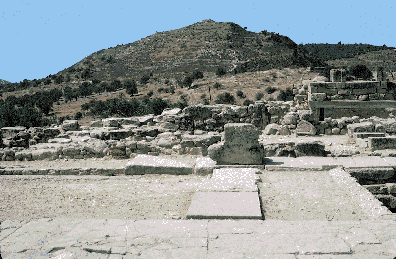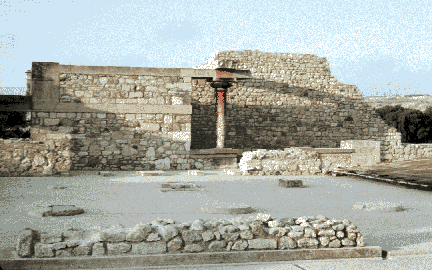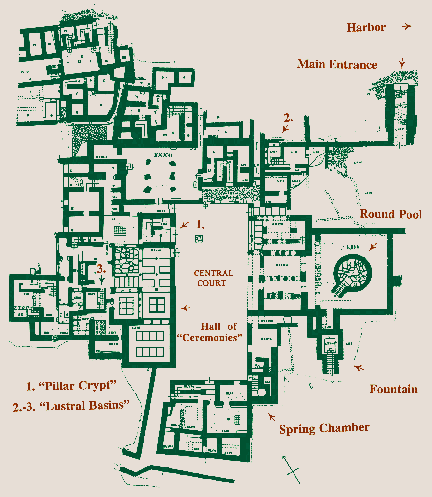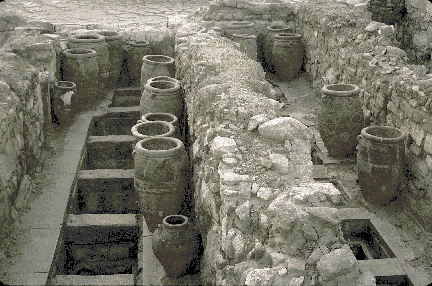|
Michele A. Miller Editor of Old World Archaeology, Athena
Review
Ancient cultures are often characterized by their most impressive monuments.
Those who seek to understand the Bronze Age civilization of Crete - known
as the "Minoans" after the legendary King Minos - have looked to a series
of complex structures, each centered around a large courtyard, for clues
to understanding Minoan society. The best-known of such structures,
Knossos, was excavated
over 100 years ago by the British archaeologist
Sir Arthur Evans, who
began work just one year before the American archaeologist
Harriet Boyd started excavating
at Gournia. Evans' discoveries at Knossos, and moreover, his interpretation
of the site as a "palace" inhabited by a powerful king, Minos, formed the
first dominant paradigm of Minoan culture.
Evans' initial vision of Bronze Age Crete, an island ruled by a single powerful
king at Knossos, had to be somewhat modified upon the rapid discovery of
similar structures in other regions of the island: Phaistos in 1901 (fig.1),
Gournia in 1907, Malia in 1915, and, much later, Zakros (fig.3) in 1963.
According to Evans' paradigm, these other palaces served as the seats of
regional governors, or perhaps of rival rulers in the earlier "Old Palace"
period, who might have been subjugated by the king of Knossos at a later
period. More recently, however, the discovery of  additional palaces at
Petras and Galatas, as
well as at Kommos and
Khania - although the
courtyards themselves have not yet been found at either site - has challenged
this long-standing, Knossos-centered view of Minoan society. Other palace
sites may also exist at Arkhanes, Stavromenos, Palaikastro, and Protoria. additional palaces at
Petras and Galatas, as
well as at Kommos and
Khania - although the
courtyards themselves have not yet been found at either site - has challenged
this long-standing, Knossos-centered view of Minoan society. Other palace
sites may also exist at Arkhanes, Stavromenos, Palaikastro, and Protoria.
Fig.1: Part of the Central Court at Phaistos (photo: Athena
Review).
In light of this new evidence, over the last few years a number of Aegean
scholars have formed a range of new theories on the function of these enigmatic
structures. Some researchers have proposed that, rather than primarily serving
as palaces or royal residences, they may have actually been built as temples,
sanctuaries, communal ritual and festival areas, or even as large necropoli
(literally, cities of the dead, or cemeteries).
History of Research: In other areas of Greece, the majority of
archaeological research has focused on the Classical and Roman periods, while
earlier remains from the Neolithic through Bronze Age have received much
less attention. On Crete, however, this focus is reversed. There are more
excavations of prehistoric (or more accurately, considering the decipherment
of the Mycenaean script, Linear
B, proto-historic and prehistoric) sites on Crete than in any other part
of the Aegean. To a large extent, this early focus is due to the density
of prehistoric remains on the island. But it also results from the unique
and intriguing character of these remains, which include large, sprawling,
asymmetrical or "labyrinthian" complexes with multiple rooms, workshops and
extensive storage areas, finely wrought arts and crafts, as well as substantial
assemblages of seals, sealings, and archives in at least two distinct scripts
- all the hallmarks of a state society. Here also, on this elongated, relatively
isolated island, many researchers (Evans chief among them) have sought an
early "European" civilization on a par with those known further to the east
in Mesopotamia and Egypt. Others have been drawn to the Minoans as providing
an earlier stratum to the more familiar Classical Greek culture.
One cannot discuss the archaeology of prehistoric Crete without addressing
the work of Sir Arthur Evans. Although his methods and theories have become
increasingly criticized as new evidence has accumulated, they nevertheless
provide the basic backbone of Minoan archaeology. Evans' interest in Crete
was piqued by his acquisition of various Minoan artifacts, especially sealstones,
and the still undeciphered scripts they contained. Evans' interest also seems
to have been fueled by a related desir e to discover an early Western culture
- particularly one with an
early writing system
comparable to those in the East. Thus, it is not surprising that he not only
compared the Minoans with the early Near Eastern civilizations, but also
adopted many of the same techniques for excavation used in the East. e to discover an early Western culture
- particularly one with an
early writing system
comparable to those in the East. Thus, it is not surprising that he not only
compared the Minoans with the early Near Eastern civilizations, but also
adopted many of the same techniques for excavation used in the East.
Fig.2: Central Court at Knossos (photo: Athena Review).
Along with the maturing of a field of study that is now over 100 years old,
there appears to be a distinct trend toward the re-evaluation of earlier
ideas and evidence. Many Minoan scholars are returning to Evans' idea that
Minoan "palace" society was influenced by the civilizations of the East.
Related to this, there has been an increase in attention to examining Minoan
interactions within the wider sphere of the Bronze Age world. Scholars are
also restudying many earlier excavations in order to clarify previous evidence,
while also examining the lives of their scholastic predecessors (e.g.,
MacGillivray 2000).
Chronology and Controversy: The Minoan civilization flourished during
the period known as the Bronze Age. By the early 20th century, researchers
had divided the Bronze Age into early, middle, and late periods. In turn,
these were subdivided into three more parts by early investigators including
Evans, who used the terms Early, Middle, and Late Minoan for the Bronze Age
of Crete. Although the term "Minoans" has come to mean the Bronze Age culture
of Crete (particularly the Middle and Late Bronze Age), the roots of this
culture can be found in earlier habitation on the island. Whether the earliest
Minoan settlements were the direct antecedents of the palaces is still a
subject of some debate (see Origins of the Palaces below), but by consensus
Minoan "palatial" society is determined to have begun roughly around the
beginning of the second millennium BC (ca. 1900 BC), with the construction
of the first palace at Knossos.
Minoan chronology is based on a tripartite system divided into relative phases
of Early, Middle and Late. Such phases are determined by the relative position
of cultural material - particularly pottery - found at Minoan sites. Thus,
as Minoan excavation and research has continued, these phases have become
increasingly refined. Archaeologists also often employ another chronological
system based on fundamental changes in Minoan society, which can be observed
in the building, rebuilding, and abandonment of the major palaces. This has
given rise to terms such as Pre-palatial, Protopalatial (sometimes referred
to as the Old Palace period), Neopalatial (or New Palace period), and
Post-palatial periods. Most scholars agree that the palaces were first built
at the beginning of MMIB, with a period of rebuilding beginning in MMIIA.
Ash layers and other evidence point to the powerful eruption of the volcano
on the island of Thera occurring at the end of the LMIA period; use of the
palaces, however, seems to have continued through the end of LMIB. At that
point, all the palaces except the one at Knossos were destroyed and abandoned,
with a related break in other cultural material. Knossos, however, was modified
and remained in use, despite at least two additional destructions in early
LMIIIA2 and LMIIIB, before finally being abandoned for good at the end of
the Bronze Age. Many scholars agree that during this last phase Knossos was
occupied (or controlled) by an intruding people, probably the Mycenaeans,
a Bronze Age civilization from mainland Greece. It is from this last phase
of occupation at Knossos that we find tablets written in the Linear B script,
deciphered as an early form of Greek.
The
Palaces: While the palaces are certainly not the only intriguing aspect
of a culture also known for its achievements in the arts, enigmatic scripts,
and l ong-distance trade relations, they are a good place to begin to understand
Minoan society. For much of what we know has been based on the excavation
and study of these large structures, which, while sharing certain characteristics
with buildings known in other Bronze Age cultures, remain distinctly "Minoan"
in character. ong-distance trade relations, they are a good place to begin to understand
Minoan society. For much of what we know has been based on the excavation
and study of these large structures, which, while sharing certain characteristics
with buildings known in other Bronze Age cultures, remain distinctly "Minoan"
in character.
While the definition of "palace" has been hotly debated, there has been much
more consensus on the essential features of these structures (at least in
the Neopalatial period, for less is known about the Old Palaces, often damaged
in later rebuilding). Some of the most characteristic features of these later
palaces include:
Fig.3: Plan of the Palace at Zakros (after Platon).
Central Court: This is the most distinct and perhaps defining feature
of the palaces, one that several scholars have argued was essential to the
development of the palace form (see
Driessen, this issue).
This court is of impressive dimensions, the largest being that at Knossos)
which measures 53 x 28 m, with those at Malia and Phaistos only slightly
smaller. Several of the authors in this feature (including
Hitchcock, and Driessen)
have noted that circulation patterns within the palaces would lead visitors
toward the Central Court. The Central Court, therefore, must have been essential
to the function of the palace. West Court: This is a smaller, open, paved
area to the west of the western palace fašade, the main approach to
the palace. Often, raised "causeways" of carefully laid limestone slabs cross
over the level of the cobbled court.
Cult Rooms along the West Side of the Central Court: Small rooms directly
along the west side of the Central Court in the major palaces have largely
been interpreted as ritual areas, on the basis of architectural features
and finds. The Pillar Crypts, also found in other positions within the palaces
and at some villa complexes, have received considerable attention.
Residential Quarters/Minoan Hall: Although their function is unknown,
the palaces appear to include a suite of rooms with roughly similar plans,
usually known as Residential Quarters. These are largely made up of the Minoan
Hall, which consists of several rectangular rooms separated by a row of columns
and a set of square piers forming a pier- and-door partition, in association
with a lightwell.
Lustral
Basin: The function of another distinctive room frequently found associated
with the Minoan Hall, the so-called Lustral Basin (fig.3), is also an open
question. This is a small room sunk down a few feet below floor level and
reached by a short stairwell, which turns and runs along a parapet.
Storage Facilities/Magazines: A significant portion of the ground
floor of the palaces was devoted to storage magazines containing large pottery
jars (pithoi), which are often found in the west wing, as at Knossos (fig.4).
Piano Nobile/Public Apartments: Many archae ologists postulate that
the Minoans built their major reception halls on the second floors of the
palaces above the storage rooms of the west wing. While these upper floors
are not preserved, scholars point to similar "halls of state" in other forms
of architecture, such as the "piano nobile" of the palazzi in Renaissance
Italy. ologists postulate that
the Minoans built their major reception halls on the second floors of the
palaces above the storage rooms of the west wing. While these upper floors
are not preserved, scholars point to similar "halls of state" in other forms
of architecture, such as the "piano nobile" of the palazzi in Renaissance
Italy.
Fig.4: The West Magazines at Knossos (photo: Athena Review).
Theatrical Area: Areas entered on two sides by shallow steps, generally
to the northwest of the palaces, have been interpreted as "theatrical areas."
Grain Silos: Large rubble-built cylindrical structures constructed
partially below the ground, known as koulores, appear to have been used for
the storage of grain - a proposal strengthened by the preservation of plaster
on the interior walls of several of these structures. Monumental Size and
Elaboration: In addition to their sheer size, notable in the palaces is the
use of highly crafted materials, such as ashlar masonry and gypsum veneering.
The palaces employed a wide variety of piers, columns, or other supports.
Decorative elements in the New Palaces include plaster reliefs, gypsum veneering,
and painted frescoes.
Despite the palaces' sharing many characteristics, several of the authors
in this feature have remarked on the distinctiveness of each palace. The
plans of no two palaces are exactly alike, each conforming to its particular
topography and regional context
Origin of the Palaces: Basically, theories about how and why the palaces
developed fall into two camps: those who believe that the Minoan structures
were in some way influenced by palaces of the Near East, versus those who
have looked to an indigenous development within Cretan society. Since most,
although not all (see
Driessen, this issue),
scholars have viewed the palaces as indicative of a "state" society - that
is, a powerful, centralized, political authority with complex and hierarchical
organization - what is often under debate is thus the emergence of state
society on Crete.
While the debate continues to unfold, one thing remains clear - more analysis
is needed of the first Old Palaces, and the possible earlier structures found
beneath them. Perhaps the recent discoveries of palaces at various sites
on Crete, from Petras
in Siteia to Khania in
the west, will provide new evidence for the origin of this distinctive Minoan
structure. Whether, in the end, we determine that the Minoan palace was purely
an indigenous form, or was modeled from buildings in the Near East, it is
important to remember that the end product was an entirely characteristic
and distinct Cretan phenomenon.
References:
Branigan, K. 1975. "Review of Myrtos." In Classical Review of Oxford 25:
116-118.
Cherry, J. 1983. "Origins of Complex Society. Evolution, Revolution and the
Origins of Complex Society in Minoan Greece." In Minoan Society (Krzyszkowska,
O. and L. Nixon, eds.), Bristol, pp. 33-45.
Cherry J. 1986. "Polities and Palaces: Some Problems in Minoan State Formation."
In Peer Polity Interaction and Socio-Political Change (Renfrew, C. and J.
F. Cherry, eds.), Cambridge Univ. Press, Cambridge, pp. 19-46.
Cadogan, G. 1976. Palaces of Minoan Crete. Methuen, London.
Cottrell, L. 1962, 1983. Bull of Minos. Efstathiadis, Athens.
Dickinson, O. 1994. The Aegean Bronze Age. Cambridge University Press.
Davaras, C. 1976. Guide to Cretan Antiquities. Eptalofos S.A., Athens.
Duhoux, Y. 1977. "Le disque de Phaestos." Archeologie, Epigraphie, Edition
critique, Index. Louvain (Peters).
Graham, J.W. 1987. The Palaces of Crete (revised edition). Princeton University
Press, NJ.
Hawes, H.B., B.E. Williams, R.B. Seager, and E.T. Hall, 1908. Gournia, Vasiliki
and other Prehistoric Sites on the Isthmus of Hierapetra, Crete: Excavations
of the Wells-Houston-Cramp-Expeditions 1901, 1903, 1904. The American Exploration
Society, Free Museum of Science and Art, Philadelphia.
Hood, M.S.F. and W. Taylor. The Bronze Age Palace of Knossos. BSA suppl.
13, London.
MacGillivray, J.A. 2000. Minotaur. Sir Arthur Evans and the Archaeology of
the Minoan Myth. Hill and Wang, New York.
Packard, D. 1974. Minoan Linear A. Univ. California.
Rehak, P. and J. G. Younger. 1998. "Review of Aegean Prehistory VII: Neopalatial,
Final Palatial, and Postpalatial Crete." American Journal of Archaeology
102:1: 91-173.
Renfrew, C. 1972. The Emergence of Civilisation. Methuen, London.
Rutter, J. "Prehistoric Archaeology of the Aegean."
http://devlab.dartmouth.edu /history bronze_age/.
Seager, R.B. 1912. Explorations in the Island of Mochlos. Boston, American
School of Classical Studies in Athens.
Shaw, J.W. 1977. "The Orientation of Minoan Palaces." AntichitÓ Crotesi,
Studi in Onore di Doro Levi II, 47-59. Rome.
Shaw, J.W. 1990. "North American Archaeological Work in Crete, 1880-1990."
Expedition, vol. 32 no. 3. University Museum, Univ. Pennsylvania, Philadelphia.
Tenwolde, C. 1992. "Myrtos Revisited. The Role of Relative Function Ceramic
Typologies in Bronze Age Settlement Analysis." In Oxford Journal of Archaeology
11 (1): 1-24.
Warren, P. 1972. Myrtos: An Early Bronze Age Settlement. British School at
Athens.
Watrous, L.V. 1994. "Review of Aegean Prehistory III: Crete from Earliest
Prehistory through the Protopalatial Period." AJA 98:4: 695-753.
Whitelaw, T. 1983. "The Settlement at Fournou Korifi Myrtos and Aspects of
Early Minoan Social Organisation." In Minoan Society (Krzyszkowska , O. and
L. Nixon, eds.), Bristol, pp. 323-345.
This is an abridged version of the article appearing on page 16-26 in Vol.3 No.3 of Athena
Review.
.
|
|